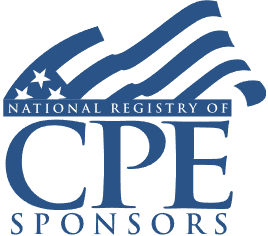Subpart F Expansion Final and Proposed Regulations: Increased Tax Liability and Reporting Obligations
Controlled Foreign Corporation and U.S. Shareholder Definitions, GILTI

Course Details
- smart_display Format
On-Demand
- signal_cellular_alt Difficulty Level
Intermediate
- work Practice Area
Tax Preparer
- event Date
- schedule Time
1:00 p.m. ET./10:00 a.m. PT
- timer Program Length
110 minutes
-
BARBRI is a NASBA CPE sponsor and this 110-minute webinar is accredited for 2.0 CPE credits.
-
BARBRI is an IRS-approved continuing education provider offering certified courses for Enrolled Agents (EA) and Tax Return Preparers (RTRP).
This course will provide tax advisers with a practical overview of the significant to Subpart F tax treatment of controlled foreign corporations (CFCs). The panel will detail in plain language the specific areas of Subpart F, including the downward attribution rules, recent final and proposed regulations, and foreign information reporting requirements on Form 5471.
Description
The Subpart F rules require U.S. shareholders of CFCs to treat certain types of income as taxable in the current year. These calculations have long presented significant challenges to tax advisers serving clients with CFC holdings. Final regulations issued in January 2022 state that flow-through entities only have Subpart F income when the individual partner is an indirect shareholder of the CFC. Additionally, proposed regulations have been issued that would allow partners and S corporation shareholders to make mark-to-market and qualifying electing fund elections. Now the inverse is true--only the partnership or S corporation can make these elections.
Continually updated legislation adds complexity to an already challenging regime. Tax advisers must also know whether the new rules create new filing obligations to avoid severe penalties for foreign information reporting noncompliance.
Listen as our authoritative panel of international tax practitioners reviews the Subpart F rules and provides a practical guide to the specific CFC ownership and reporting obligations.
Outline
- Impact of U.S. International Tax Reform: An Overview
- Subpart F’s CFC Rules: Expansion & Contraction of § 951(a)’s Application
- Six ways Subpart F’s purview was expanded by the 2017 TCJA
- Strategies to mitigate effects of § 318’s downward attribution rules due to Congress’ repeal of § 958(b)(4)
- Rev. Procedure 2019-40’s three safe harbors; Reporting examples
- Entity selection and check-the-box considerations
- Final January 2022 Regulations limiting Subpart F income; Examples
- US partnerships as US shareholders
- Proposed regulations offering mark-to-market QEF elections
- Global Intangible Low Taxed Income – Code § 951A
- Overview and recent final GILTI regulations
- Mechanics and computation
- Tax planning strategies
- Reporting considerations
- Examples
- Tax Planning Strategies and Pitfalls
- The § 962 election: determining whether making the election is optimal, mechanics, reporting
- The High-Tax Subpart F and GILTI Opt-out Elections
- Longstanding Subpart F High-Tax Exception of § 954(b)(4)
- GILTI High-Foreign Tax Exclusion (Final 2020 Regs).
- The 2020 Proposed “Unitary” High-Tax Annual Exclusion Election
- Practical tax planning opportunities given recent IRS administrative guidance
- Tax traps to avoid
- Key Takeaways and Q&A
Benefits
The panel will discuss these and other important topics:
- How the proposed and final regulations affect Subpart F income
- Constructive ownership tests in CFCs, including downward attribution rules
- How the Subpart F changes run counter to the tax law's general aim to convert to more territorial taxation of U.S. taxpayers as opposed to global-based
- Treatment of earnings invested in U.S. property
NASBA Details
Learning Objectives
After completing this course, you will be able to:
- Determine how the definition of U.S. shareholders subject to tax on previously deferred foreign-source income has changed
- Distinguish the tax provisions under Subpart F from the GILTI provisions
- Recognize the treatment of foreign tax credits
- Ascertain whether income is Subpart F income and the tax consequences if income is classified as Subpart F income
- Decide the best way to repatriate income and to pay taxes on the repatriation of foreign untaxed earnings
- Field of Study: Taxes
- Level of Knowledge: Intermediate
- Advance Preparation: None
- Teaching Method: Seminar/Lecture
- Delivery Method: Group-Internet (via computer)
- Attendance Monitoring Method: Attendance is monitored electronically via a participant's PIN and through a series of attendance verification prompts displayed throughout the program
- Prerequisite: Three years+ business or professional experience at mid-level within the organization, preparing complex tax forms and schedules. Specific knowledge and understanding of international taxation, deferred foreign-source income, earnings and profits, controlled foreign corporations, specified foreign corporations, and repatriation of deferred foreign earnings; familiarity with accumulated cash and non-cash retained earnings and profits and netting of earnings and profits positions

Strafford Publications, Inc. is registered with the National Association of State Boards of Accountancy (NASBA) as a sponsor of continuing professional education on the National Registry of CPE Sponsors. State boards of Accountancy have final authority on the acceptance of individual courses for CPE Credits. Complaints regarding registered sponsons may be submitted to NASBA through its website: www.nasbaregistry.org.

Strafford is an IRS-approved continuing education provider offering certified courses for Enrolled Agents (EA) and Tax Return Preparers (RTRP).
Unlimited access to premium CLE courses:
- Annual access
- Available live and on-demand
- Best for attorneys and legal professionals
Unlimited access to premium CPE courses.:
- Annual access
- Available live and on-demand
- Best for CPAs and tax professionals
Unlimited access to premium CLE, CPE, Professional Skills and Practice-Ready courses.:
- Annual access
- Available live and on-demand
- Best for legal, accounting, and tax professionals
Related Courses
Recommended Resources
Building Your Book: Strategies to Secure Long-Term Success
- Business & Professional Skills
- Career Advancement
- Talent Development
